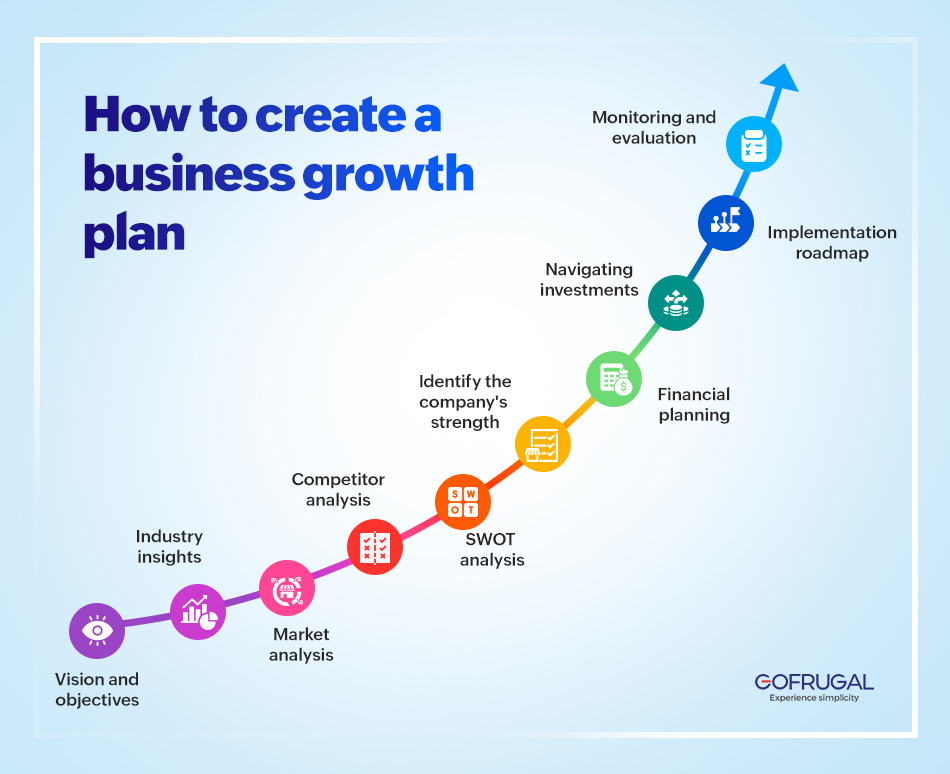Contents
- What is business growth plan
- Why is a business growth plan important?
- How to create a business growth plan
- Tips for creating an effective business growth plan
- 6 business growth strategies
- Role of ERP software in business growth
What is business growth plan?
A business growth plan is like a roadmap that helps your company grow by outlining specific steps to expand operations and increase its presence in the market. It's like a guide that helps you make decisions for sustainable and scalable growth in the ever-changing business world. Having a good growth plan in business is important for long-term success, helping businesses overcome challenges and take advantage of opportunities.
Why is a business growth plan important?
A business growth plan is crucial for long-term success, helping companies to navigate challenges and seize opportunities.
- Versatile expansion: A business growth plan involves enhancing and expanding operations, whether it's extending your business footprint, broadening the customer base, or diversifying offerings to amplify profits.
- Customer satisfaction: Prioritizing growth plans in business ensures staying on top of trends, keeping existing customers satisfied, and acquiring new ones, fostering a positive business-customer relationship.
- Healthy competition: It allows businesses to compete effectively, not just with survival in mind, but also in maintaining a healthy cash flow, improving profits, and minimizing financial losses and economic vulnerabilities.
- Long-term vision: Business development strategies are integral for navigating the ever-changing business landscape, meeting long-term goals, and ensuring the overall health and resilience of your business.
How to create a business growth plan

Evaluate your business
Begin by understanding where your business stands. Conduct a thorough SWOT analysis to identify Strengths, Weaknesses, Opportunities, and Threats. This data-driven approach lays the foundation for informed decision-making, enabling you to capitalize on your strengths and address potential challenges. Understanding these elements is key to knowing how to write a growth plan that fits your company's unique needs.
Defining your vision and objectives
Clearly articulate your business vision. Set SMART objectives—Specific, Measurable, Achievable, Relevant, and Time-bound—ensuring goals are clear, realistic, and in sync. Foster teamwork for a shared understanding and regularly reassess and adjust objectives to stay adaptable in the ever-changing market landscape. This meticulous approach not only propels success but also nurtures a culture of adaptability, vital for sustained growth. This approach is critical when considering business development strategies and working towards the growth business plan you envision.
Market analysis
In creating your business growth plan, it's important to perform a thorough market analysis to learn about your industry, audience, and rivals. Understand your customers not just by age but by what they like. Keep an eye on trends and use feedback to fine-tune your growth strategy. Look for unique markets, follow the rules, and team up with others for steady business growth. This simple approach ensures your business development strategies are well-informed and strategically crafted.
Competitive landscape
Carefully study your competitors, pinpointing unique selling propositions (USPs) that set your business apart. As you work on your business development strategies, emphasize the critical role of differentiation in a crowded market. Beyond just products, focus on outstanding customer service or innovative solutions to further distinguish your brand. Regularly reassess the market landscape as part of your business growth planning to adapt your business development strategies and stay ahead.
SWOT analysis
By conducting a SWOT analysis, businesses can make informed decisions, capitalize on their strengths, address weaknesses, take advantage of opportunities, and prepare for potential threats, ultimately contributing to strategic planning and sustainable growth.
- Strengths: A business's internal factors that offer an advantage over other companies.
- Weaknesses: A business's internal factors that put it at a disadvantage compared to other companies.
- Opportunities: External factors that a business can capitalize on to achieve its objectives.
- Threats: External factors that may pose challenges or risks to a business.
Financial planning
Explore budgeting and forecasting as practical tools for a solid financial foundation in your business growth plan. Regularly review and adjust your budgets based on performance. Consider different funding options, like loans or investors, if necessary. Implement sound financial management practices, such as tracking key performance indicators (KPIs), maintaining an emergency fund, and fostering positive cash flow. Ensure that your business development strategies remain on a sustainable trajectory.
Implementation roadmap
Break down your business growth plan into actionable steps with a clear timeline, emphasizing adaptability for unforeseen circumstances. Foster a collaborative team environment, ensuring alignment with plan objectives. Regularly assess progress and celebrate milestones to maintain your momentum. This approach keeps your business moving forward and builds a strong, motivated team, which is vital for business growth planning.
Monitoring and evaluation
Continuous monitoring and evaluation are crucial to the success of your business growth plan. Track key performance indicators (KPIs) such as revenue growth, customer acquisition rates, and return on investment to measure progress. Also, keep an eye on employee engagement and customer satisfaction to maintain a well-rounded approach to business development strategies. Regularly reviewing these metrics helps you make smart adjustments and stay on track with your business growth strategy.
Tips for creating an effective business growth plan
Identify the company's strengths
Identify and use your company's strengths through regular SWOT analysis, revealing opportunities, and staying flexible. Improve internal abilities to build a culture of innovation and adaptability. Also, gather customer feedback and follow market trends to discover hidden strengths. This strategic approach helps move your business forward and makes it stand out in a competitive environment. These insights are key when considering how to write a growth plan for your business.
Gain industry knowledge
Learn from others by studying their business development strategies. Focus on both their successes and challenges to gather lessons. Benchmarking against industry leaders gives useful insights. Keep learning by attending conferences and networking events, which will help refine your business growth planning.
Strengthen your team
Recognize the key role of your team in your business growth plan. Build a culture of open communication and encourage innovation. Strengthen collaboration and skills by creating strategies to develop your team. Provide ongoing training to ensure your team is up to date with industry trends and new technologies. A motivated, skilled team is essential for effectively carrying out your growth business plan.
Plan for investments
When seeking growth funding, take a strategic approach with potential investors. Focus on your strengths and growth potential while showing clear milestones and a detailed plan for how you will use the funds. This thoughtful approach helps attract investors and builds confidence in your vision, making your business growth plan more convincing.
Enhance marketing efforts
Integrating marketing into your business growth plan isn't just about visibility—it's about telling a story that connects with your audience. Understand your customer's journey, tailor messages accordingly, and utilize diverse channels for maximum impact. A well-crafted marketing strategy woven into your business growth plan becomes a powerful tool for building brand loyalty and attracting new customers, playing a big part in your business growth strategy.
Grow your network
Networking is more than advice; it's about growing together. Use your network not only for insights but for partnerships and collaborations. Tap into shared knowledge to find new solutions and offer your expertise in return. A strong network can be a key driver in executing your business development strategies, providing support, and opening up new opportunities.
6 business growth strategies
Market penetration
Focus on increasing market share by selling more of your existing products to your current customer base. This business growth strategy could involve enhancing marketing efforts, offering promotions, or expanding distribution channels to attract new customers from the same market.
Product development
Introduce new products or improve existing ones to meet the evolving needs of your customers. This business growth planning approach helps you stay relevant, attract new buyers, and keep your current customers engaged. Product development can also open doors to unexplored customer segments.
Market expansion
Explore new markets for your existing products, whether by entering new geographical regions or targeting different demographics. Expanding to new areas can help diversify revenue streams and spread risk.This tactic diversifies revenue streams, spreads risk, and offers a clear business growth plan example of how to expand a company's footprint.
Diversification
Enter new markets with new products. Though riskier, this business growth strategy can provide substantial growth opportunities by diversifying the company’s offerings and reaching completely new customer bases, reducing dependence on one product or market.
Partnerships and collaborations
Form strategic partnerships with other businesses that complement your services or products. This collaborative business growth strategy can help you tap into new customer bases, share resources, and co-create innovative offerings, fostering mutual growth.
Customer retention
Keep a strong focus on customer satisfaction and retention. By building loyalty through exceptional service, personalized experiences, and ongoing engagement, you can reduce churn, drive repeat business, and foster positive word-of-mouth growth.
Role of ERP software in business growth
Gofrugal ERP stands out as an easy-to-use, affordable, and smart collaborative platform, seamlessly integrating with various marketplaces, e-commerce platforms, loyalty providers, and more. Offering simplicity in business processes, it plays a crucial role in your business growth plan by empowering users to choose their preferred devices, and making ERP accessible and user-friendly.
Gofrugal reduces billing time, minimizes data entry tasks, and requires minimal staff involvement, enhancing operational efficiency. With easy learning curves and no strict educational prerequisites, it ensures widespread usability. This ERP solution elevates decision-making with 100% accuracy and timeliness, providing reliable business insights. Most notably, Gofrugal ERP is flexible, allowing businesses to adapt to changing needs in an agile manner, facilitating digital transformation in simple, incremental steps.
Ready to level up?
A business growth plan is your key to long-term success in the business game. See where you stand, set a clear vision, and analyze everything. Add financial smarts, and a solid roadmap, and keep an eye on things. These tips are your secret weapon to outshine and outpace the competition and make your business dreams a reality. Get ready, stay flexible, and watch your business grow like never before.

